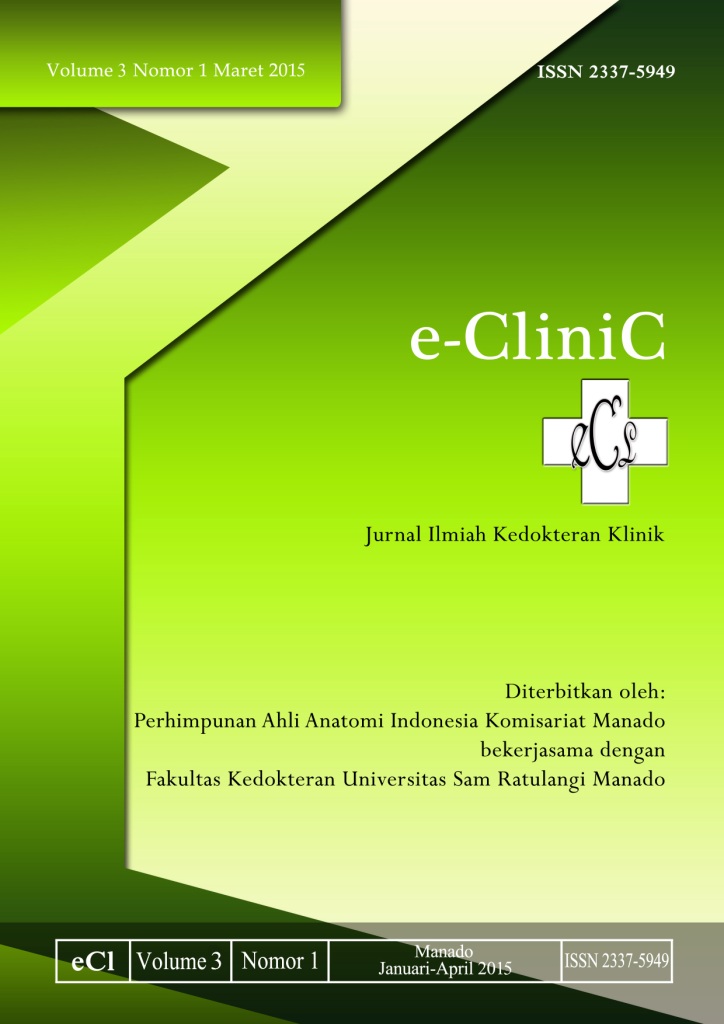PROFIL PASIEN SIROSIS HATI YANG DIRAWAT INAP DI RSUP PROF. DR. R. D. KANDOU MANADO PERIODE AGUSTUS 2012 – AGUSTUS 2014
DOI:
https://doi.org/10.35790/ecl.v3i1.6841Abstract
Abstract: Cirrhosis hepatic is a pathological condition that describes the final stage of progressive hepatic fibrosis and characterized by distortion of the liver and regenerative nodule formation. Cirrhosis hepatic is a chronic liver disease caused by various factors such as infection by hepatitis B virus, hepatitis C and alcohol. Cirrhosis ranks eighteenth cause of death with a prevalence of 1.3% in the world. Methods: This study is a retrospective descriptive study by collecting secondary data from medical record of cirrhotic patients installation of medical records RSUP Prof. Dr. R. D. Kandou Manado, August 2012 to August 2014. The data were obtained amounted to 51 patients with cirrhosis hepatic. Results: The result showed that the highest proportion in cirrhotic patients by gender is male (62.7%), age group 50-59 years (31.4%), the most common cause is HBV infection (37.3%), ascites and abdominal distension (20%) is a clinical picture that often arise, increased AST (15%) and loss of albumin and hemoglobin (16%) is the laboratory results that often abnormal, and most complications are esophageal varices (23.5%). Conclusion: Cirrhosis affects many men, in the age group 50-59 years, HBV infection is the most common cause, ascites and abdominal distension as common clinical features, increased SGOT and a decrease in albumin and hemoglobin as the most common abnormal laboratory picture, and most complications namely esophageal varices.
Keywords: profile, cirrhosis hepatic, hepatitis
Abstrak: Sirosis hati merupakan keadaan patologis yang menggambarkan stadium akhir fibrosis hepatik yang berlangsung progresif ditandai dengan distorsi dari arsitektur hepar dan pembentukan nodulus regeneratif. Sirosis hati adalah penyakit hati kronis yang disebabkan oleh berbagai macam faktor seperti infeksi virus hepatitis B, hepatitis C dan alkohol. Di dunia sirosis menempati urutan kedelapan belas penyebab kematian dengan prevalensi 1,3%. Metode: Penelitian ini merupakan penelitian deskriptif retrospektif dengan cara mengumpulkan data sekunder berupa catatan rekam medik pasien sirosis di Instalasi Rekam Medik RSUP Prof. Dr. R. D. Kandou Manado Periode Agustus 2012-Agustus 2014. Keseluruhan data yang diperoleh berjumlah 51 pasien sirosis hati. Hasil: Dari hasil penelitian diperoleh proporsi tertinggi pada pasien sirosis berdasarkan jenis kelamin adalah laki-laki (62,7%), kelompok umur 50-59 tahun (31,4%), penyebab terbanyak infeksi HBV (37,3%), asites dan distensi abdomen (20%) merupakan gambaran klinis yang sering muncul, peningkatan SGOT (15%) serta penurun albumin dan Hb (16%) merupakan gambaran laboratorium yang hasilnya sering abnormal, dan komplikasi terbanyak adalah varises esofagus (23,5%). Simpulan: Sirosis hati banyak diderita oleh laki-laki, pada kelompok umur 50-59 tahun, infeksi HBV adalah penyebab terbanyak, asites dan distensi abdomen sebagai gambaran klinis tersering, peningkatan SGOT serta penurunan albumin dan Hb sebagai gambaran laboratorium abnormal tersering, dan komplikasi terbanyak yaitu varises esofagus.
Kata kunci: profil, sirosis hati, hepatitis
Downloads
Published
How to Cite
Issue
Section
License
COPYRIGHT
Authors who publish with this journal agree to the following terms:
Authors hold their copyright and grant this journal the privilege of first publication, with the work simultaneously licensed under a Creative Commons Attribution License that permits others to impart the work with an acknowledgment of the work's origin and initial publication by this journal.
Authors can enter into separate or additional contractual arrangements for the non-exclusive distribution of the journal's published version of the work (for example, post it to an institutional repository or publish it in a book), with an acknowledgment of its underlying publication in this journal.
Authors are permitted and encouraged to post their work online (for example, in institutional repositories or on their website) as it can lead to productive exchanges, as well as earlier and greater citation of the published work (See The Effect of Open Access).







